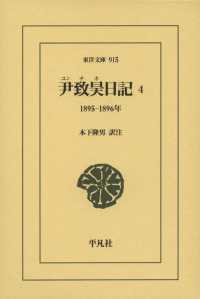- ホーム
- > 洋書
- > 英文書
- > Philosophy
Full Description
This landmark classic marks the beginning of a new approach to Indian philosophy. While older approaches were born from the assumption that critical thinking was unknown to the East and all philosophical endeavor was assumed to be a manifestation of religious doctrine or a form of mysticism, Matilal brilliantly succeeds in dispelling these assumptions and so opens up the rich traditions of Indian philosophical analysis to the modern reader.
Is reality actually knowable and therefore expressible in language? Matilal locates his analysis in this central debate and brings in Indian philosophical texts as pivotal, canonical statements of epistemological and methodological relevance. This edition incorporates additions and changes made by Matilal in his personal copy. Edited and with a preface by Jonardon Ganeri, the volume is a lucid introduction to the varied legacy of Indian philosophical analysis.
Contents
Preface to the New Edition: J. Ganeri ; Preface to the First Edition ; Chronological Table of Philosophers ; l. Perception and Language ; 1.1. General remarks on the problem ; 1.2. Early NyaAya theory of perception ; 1.3. The rise of idealism ; 1.4. Bhartr?hari's theory of knowledge: 'Construction'(vikalpa) ; 1.5. Din?naAga's theory of perception ; 1.6. Word-meaning as 'exclusion' (apoha) ; 1.7. Din?naAga and modem reductionism ; 2. Individuals, Universals, and Perception ; 2.1. A critique of the Din?naAga school ; 2.2. Material bodies and their atomic constituents ; 2.3. 'Inseparable' relation (saAmavaAya) ; 2.4. The law of contradiction and the 'delimitors' ; 2.5. Universals as meanings of general terms ; 2.6. Uses of articles and quantifiers: 'Modes' of reference ; 2.7. The problem of 'real' universal (jaAti) ; 2.8. The notion of 'propositional' perception ; 2.9. Non-qualificative perception in Navya-nyaAya: 'Simple' properties ; 2.1 0. Terms and propositional assertions ; 3. Early Grammarians on Philosophical Semantics ; 3.1. Preliminary remarks ; 3.2. The notion of 'substance' : PaAn?inias rule 1.2.64 ; 3.3. 'Substance' and 'quality': PaAn?inias rule 5.1.119 ; 3.4. Two aspects of meaning: VyaAd??i and VaAjapyaAyana ; 3.5. Bhartrhari's definition of 'substance' ; 3.6. VyaAd??i's theory of meaning ; 3.7. An analysis of VyaAd??i's theory in modem terminology ; 4. Empty Subject Terms in Logic ; 4.1. Non-referring expressions in language ; 4.2. The riddle of 'non-being' ; 4.3. The status of 'example' in Indian logic ; 4.4. The NyaAya-Buddhist controversy ; 4.5. The epistemological significance of the controversy ; 4.6. The implicit NyaAya semantic principle ; 4.7. Interpretation of existence and negation ; 4.8. The pan-fictional approach of Buddhism ; 5. Negation and the MaAdhyamika Dialectic ; 5.1. The MaAdhyamika attitudeaaemptiness' ; 5.2. Two levels of truth ; 5.3. The indeterminacy of the phenomenal world ; 5.4. The paradox of 'emptiness' ; 5.5. Sophistry and the semantical paradoxes ; 5.6. Two aspects of negation ; 5.7. 'Mysticism' and the MaAdhyamika school ; Bibliographical References ; Index







